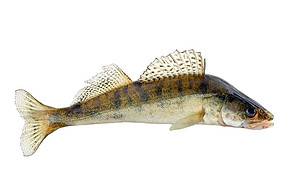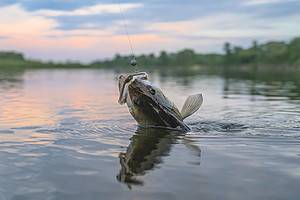The walleye is a freshwater fish in the perch family. If you happen to be an avid fisher, then you’ll know that the walleye is one of the most popular game fish.
Walleye are indigenous to the Great Lakes area, the Missouri River basin, the upper Mississippi River basin, and Canada. You can even find them down in the south, toward North Carolina along the Atlantic Coast, west to Arkansas, and north along the Missouri River.
The walleye gets its name from its cloudy, opaque eye, which is generated by a reflecting coating of a pigment called the tapetum lucidum. This layer allows it to see in low light conditions. This is especially helpful for them since they are nocturnal fish.
You’ll mostly find them hanging out in cool, deep waters. This is why they enjoy rivers, reservoirs, and lakes so much.
Interested in learning more about this fishy predator? Together we’ll explore what the walleye eat and how their diet impacts the ecosystem.
What Do Walleye Eat?
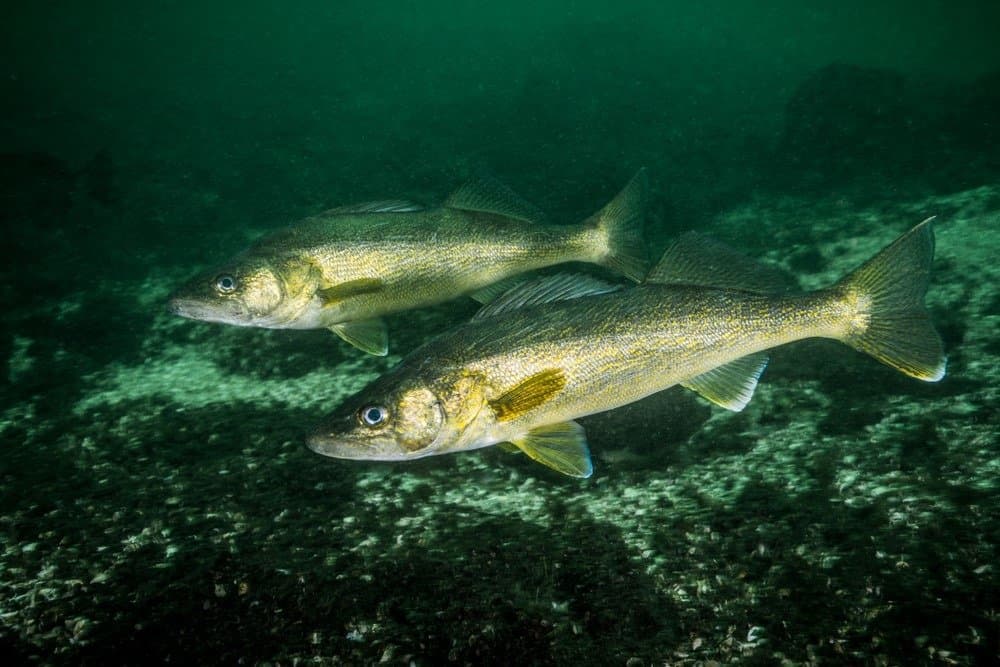
Walleyes are a member of the perch family.
©RLS Photo/Shutterstock.com
Walleye eat a diet that consists of other fish, including tiny fish, crustaceans, and insects like mayflies. They are predominately carnivores. Feeding for them takes place largely around dark and dawn as they are nocturnal.
The type of food the walleye eats includes:
- Small fish, such as yellow perch, minnows and freshwater drum
- Aquatic insects like mayflies
- Crayfish
- Snails
- Mudpuppies
- Salamanders
- Frogs
- Leeches
However, they are not picky eaters. When food options are limited, this opportunistic fish will broaden its diet to include almost any organism it may snag up. When it comes to walleye feeding habits, they will often eat all throughout the night. On days when the sky is cloudy and overcast, they may even eat well after sunrise.
A study in the Journal of Great Lakes research was focused on extensive research into the walleye diet as Lake Winnipeg has the second largest commercial walleye fishery in North America.
What they found was that despite the existence of other potential food species, walleye in the North Basin of Lake Winnipeg solely ate huge rainbow smelt, with few other prey types included in the diet. Walleye diets in the South Basin had a more diverse species composition, whereas, in the North Basin, the diet consisted almost entirely of the introduced rainbow smelt. Scientists noticed enhanced walleye growth and condition in the ones consuming excessive smelt.
How Do Walleye’s Forage for Food?
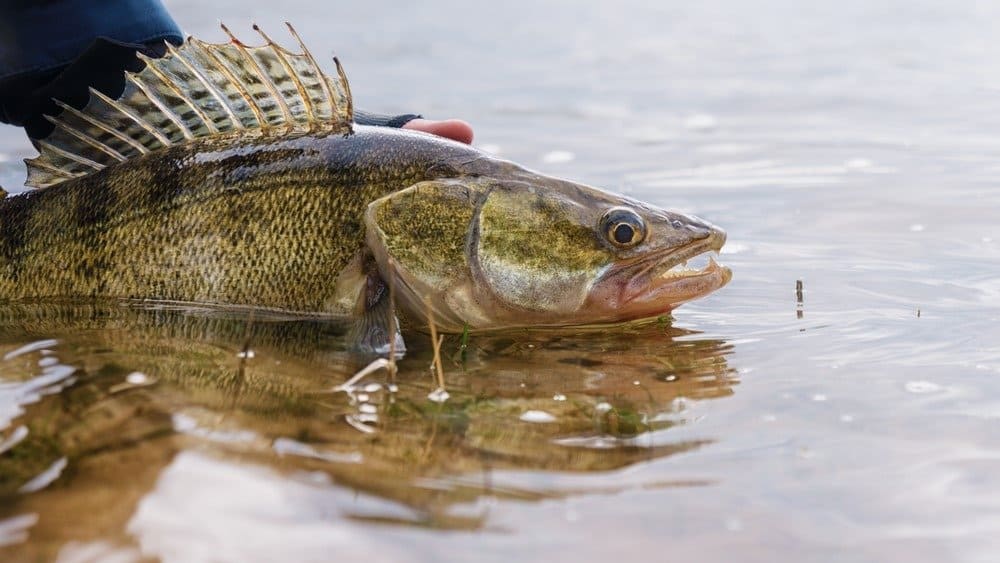
Walleye fish are considered ambush predators because of how they hunt.
©wwwarjag/Shutterstock.com
As mentioned above, the walleye gets its name from its eyes, which have a reflecting layer of pigment that helps it see in murky waters. This unique way of seeing, as well as its razor-sharp teeth, makes this fish an impressive predator. They have an immediate advantage over their prey, thanks to this.
Because they’re so sharp and strong, their teeth and jaws have little trouble breaking open large crustaceans. This is how and why walleye are able to eat so much crayfish. They are considered ambush predators as that is the hunting style they use to capture prey.
What Animals Eat Walleye?

The walleye is one of the healthiest freshwater fish to eat in America.
©FedBul/Shutterstock.com
Adult walleyes are one of the top predators in their habitat that mostly consume other fish. Except for humans, who capture and devour adult walleye, they have no natural predators in their ecosystem. However, smaller, less mature walleyes and eggs are often susceptible to being eaten by other fish. In order to avoid being eaten, young walleyes will remain near coverings, where they can hide from bigger fish.
Here is a comprehensive list of the predators that the walleye must keep an eye out for:
Many humans enjoy catching walleyes to cook a meal with afterward. Like other fish, walleye are particularly high in omega-3 fatty acids, which are beneficial for your health. Walleye also includes vitamin D, which works in conjunction with calcium to keep your bones healthy.
How Does A Walleye’s Diet Impact the Ecosystem?
The walleye is an important part of the ocean’s ecosystem. As top predators, they are responsible for keeping fish and invertebrate populations in check. Walleye are also important in the environment because they assist the movement of other species like mussels, which ride in their gills during their larval stage.
Walleye, like other migratory fish, use different areas of certain lakes at different times of their lives. When they are tiny fry, they reside in coastal marshes or shallow, rocky reefs, but as adults, they go into deeper portions of lakes.
The walleye also supports a sizable fishing business, notably in the Central United States and the Great Lakes region. Walleye and other sport fish species provide tens of millions of dollars to the Western Lake Erie Basin economy. The thriving walleye population of Lake Erie fuels Ohio’s economy.
Are Walleyes Considered an Endangered Species?
The population of walleye has continued to remain relatively stable. However, climate change, drainage systems, pollution, overfishing, and poor water quality are all threats to this species. The blue pike (Sander vitreus), one of the subspecies, is thought to be extinct.
In Ohio, it has been noted that the walleye are beginning to face a catastrophic population drop as warmer lakes decimate their food sources and increase their chances of being threatened by invasive species. Lake Erie supplies the most fish for human consumption than all of the other Great Lakes combined.
However, as climate change continues to worsen, the walleye’s home and main source of food become threatened. By the end of the century, Lake Erie’s water levels, which are now considered below normal, may drop between four and five feet, affecting the coastal habitat and lowering the quality of the water.
As a result of increasing temperatures, the Great Lakes’ internal water cycling might also be altered, potentially leading to oxygen-deficient zones (dead zones) and mass fish mortality.
Bonus: Where Are the Best Lakes for Catching Walleye?
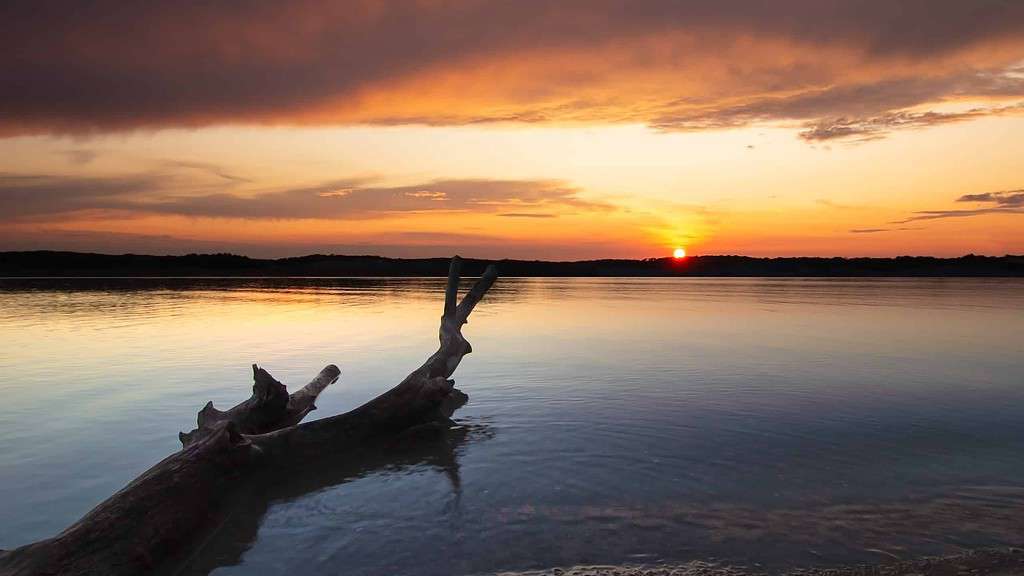
Dale Hollow Lake in Tennessee contains a lot of Walleye and bass.
©Kimberly Boyles/Shutterstock.com
Walleye are fun to catch and delicious to eat – so you may wonder where to fish for these fisher’s favorites. Here are six walleye fishing spots that rank high on all angler’s lists:
- Dale Hollow Lake, Tennessee. Dale Hollow is known mostly for bass fishing – but anglers know that there are many large walleye ready and waiting. They grow them big in Tennessee – the largest walleye ever caught was located two hours away!
- Lake of the Woods, Minnesota. This lake considers itself to be the Walleye Fishing Capital of the World – and with good reason! They are plentiful and sizable and bite year-round.
- Saginaw Bay, Michigan. This is the best spot for walleye in Michigan and a favorite of anglers all over the country.
- Lake Winnebago, Wisconsin. The best spot for walleye in Wisconsin and a popular destination for anglers.
- Mille Lacs Lake, Wisconsin. This popular lake is one of the best fisheries in the world and is known for great ice fishing and large walleye.
- Lake Francis Case, South Dakota. As one of the best walleye spots in the country – Lake Francis Case is known for walleye in the 30-38 inch range. A trip here practically guarantees a great catch!
Summary of What Walleyes Eat?
| Number | Food |
|---|---|
| 1 | Small fish, such as yellow perch, minnows and freshwater drum |
| 2 | Aquatic insects like mayflies |
| 3 | Crayfish |
| 4 | Snails |
| 5 | Mudpuppies |
| 6 | Salamanders |
| 7 | Frogs |
| 8 | Leeches |
The photo featured at the top of this post is © wwwarjag/Shutterstock.com
Thank you for reading! Have some feedback for us? Contact the AZ Animals editorial team.




